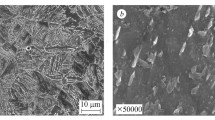Conclusions
The percentage of ductile components in the fracture after tempering decreases, but the fracture remains intragranular and also comprises longitudinal shear.
Similar content being viewed by others
Literature cited
Yu. L. Kirsanov and A. G. Venchikov, "Fracture of spring steel wire," Metal. i Term. Obrabotka Metal., 11, 70–71 (1970).
A. Fillips et al., Electron Fractography Handbook (1965).
J. Crussard et al., in: Atomic Mechanism of Failure [Russian translation], Metallurgizdat, Moscow (1963), p. 547.
L. Godecki, Wire Industry,38, 454, 719–724 (1971).
Additional information
Izhevsk Mechanical Institute. Translated from Metallovedenie i Termicheskaya Obrabotka Metallov, No. 6, pp. 56–57, June, 1973.
Rights and permissions
About this article
Cite this article
Kirsanov, Y.L., Venchikov, A.G. Fracture of spring steel wire after low-temperature tempering. Met Sci Heat Treat 15, 506–507 (1973). https://doi.org/10.1007/BF01153277
Issue Date:
DOI: https://doi.org/10.1007/BF01153277




